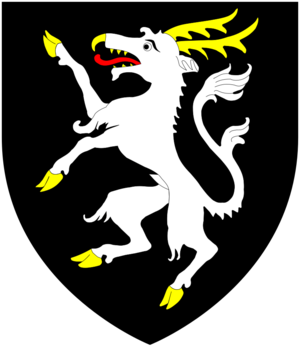Edward Harris (Irish judge) facts for kids
Sir Edward Harris (1575–1636) was an important judge and politician in Ireland during the 1600s. He was born in Cornworthy, England. Edward became the Chief Justice of Munster, a big region in Ireland. He also served as a Member of Parliament for Clonakilty from 1613 to 1615.
Edward Harris was the grandfather of Valentine Greatrakes, a famous faith healer. His sister, Anne Southwell, was a well-known poet. People said Edward was a wealthy man who made many friends in Ireland. He liked to show his wealth by wearing a valuable jewel on a gold chain. He was also a very loving father, especially to his daughters.
Early Life and Family
Edward Harris was born in Cornworthy, Devon, England. He was the oldest son of Sir Thomas Harris of Cornworthy Priory. His father was a respected lawyer. Edward's mother was Elizabeth Pomeroy, who came from an old and important family.
Sir Thomas Harris was known for his intelligence and learning. He served in the English Parliament for many years. People admired his speaking skills and hard work. Edward's grandfather, also named Edward Harris, bought Cornworthy Priory when monasteries were being closed down. Edward's older sister, Anne, became Lady Southwell and was a famous poet.
His Career in Ireland
Edward Harris began his legal training in 1598 at Middle Temple. He became a lawyer in 1599. In 1608, he moved to Ireland to become the Chief Justice of Munster. From the start, he was a close friend and partner of Richard Boyle, 1st Earl of Cork. Lord Cork was a very powerful political figure in Ireland.
Lord Cork helped Edward Harris get a seat in the Irish House of Commons. Edward represented Clonakilty in the Irish Parliament from 1613 to 1615. At that time, judges in Ireland could also be members of Parliament. Edward received special land for his "extraordinary services" to the King. He was made a knight in 1619.
In 1623, he became a Justice of the Court of King's Bench in Ireland. A year later, his favorite daughter, Elizabeth, sadly died. Edward built a memorial for her at Kinsalebeg Church. He also served as the Treasurer of the King's Inn in 1632.
Family Life
Edward Harris married twice. His first wife was Elizabeth Fowell (died 1622). They had seven children who survived:
- Sir Thomas Harris: His oldest son and heir.
- Mary Harris: She married William Greatrakes and was the mother of the famous faith healer Valentine Greatrakes.
- Phillipa Harris: She married Robert Tynte. Her family line led to the Tynte baronets of Wicklow.
- Elizabeth Harris: She was her father's favorite child. She married Rev. John Lancaster.
- Arthur Harris: He died in 1640.
- Edmund Harris: He died in 1643.
After Elizabeth died, Edward married Jane Bussey. Jane was a wealthy widow. This second marriage brought Edward even more money, including a horse breeding farm. Sadly, all of Edward's sons died without having children before 1645. This led to long arguments among his daughters and other relatives over who would inherit his wealth.
Death and Burial
Sir Edward Harris died in County Cork, Ireland, in 1636. He was first buried in Kilcredan cemetery. Later, it seems he was re-buried in Cornworthy, England. This is suggested by an inscription on a large monument to his parents in St Peters Church, Cornworthy.
The inscription on his parents' tomb reads:
- Here lieth the Right Worshipful Sr Thomas Harris Knight Sargat at Lawe And The Ladye Elizabeth His wife Wyth There Foure Children. There Eldest Sonne Edward Chief Justice of Munster in Irelande, There seconde Sonne Christopher Slayne in the Warres at Zealand in Flaunder and Their Eldest daughter Anne married to Sr Thomas Souphwell a Knight of Suffolk. And Their youngest Daughter Honer Married to Sr Hugh Harris a Knight of Scotland.
There is also a monument to Edward Harris and his first wife, Elizabeth Fowell, at the ruins of Kilcredan Church in Cork. It is now very damaged. Edward's will caused many disagreements among his family members. This led to legal battles that lasted for decades.



